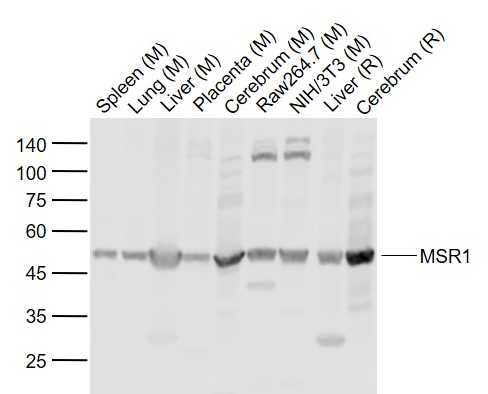anti-CD204 / MSR1 antibody [2F8]
ARG22421
ApplicationsFlow Cytometry, ImmunoPrecipitation, Western Blot, ELISA, ImmunoHistoChemistry, ImmunoHistoChemistry Frozen
Product group Antibodies
ReactivityMouse
TargetMsr1
Overview
- SupplierArigo Biolaboratories
- Product Nameanti-CD204 / MSR1 antibody [2F8]
- Delivery Days Customer23
- ApplicationsFlow Cytometry, ImmunoPrecipitation, Western Blot, ELISA, ImmunoHistoChemistry, ImmunoHistoChemistry Frozen
- CertificationResearch Use Only
- ClonalityMonoclonal
- Clone ID2F8
- Concentration1 mg/ml
- ConjugateUnconjugated
- Gene ID20288
- Target nameMsr1
- Target descriptionmacrophage scavenger receptor 1
- Target synonymsMRS-A, MSR, MSR-A, SR-A, SR-AI, SR-AII, Scara1, Scvr, macrophage scavenger receptor types I and II, macrophage acetylated LDL receptor I and II, scavenger receptor type A
- HostRat
- IsotypeIgG2b
- Scientific DescriptionThis gene encodes the class A macrophage scavenger receptors, which include three different types (1, 2, 3) generated by alternative splicing of this gene. These receptors or isoforms are macrophage-specific trimeric integral membrane glycoproteins and have been implicated in many macrophage-associated physiological and pathological processes including atherosclerosis, Alzheimers disease, and host defense. The isoforms type 1 and type 2 are functional receptors and are able to mediate the endocytosis of modified low density lipoproteins (LDLs). The isoform type 3 does not internalize modified LDL (acetyl-LDL) despite having the domain shown to mediate this function in the types 1 and 2 isoforms. It has an altered intracellular processing and is trapped within the endoplasmic reticulum, making it unable to perform endocytosis. The isoform type 3 can inhibit the function of isoforms type 1 and type 2 when co-expressed, indicating a dominant negative effect and suggesting a mechanism for regulation of scavenger receptor activity in macrophages. [provided by RefSeq, Jul 2008]
- ReactivityMouse
- Storage Instruction-20°C
- UNSPSC12352203




![FACS analysis of J774 cells using GTX42279 MSR1 antibody [2F8].](https://www.genetex.com/upload/website/prouct_img/normal/GTX42279/GTX42279_5339_FACS_w_23060820_559.webp)
